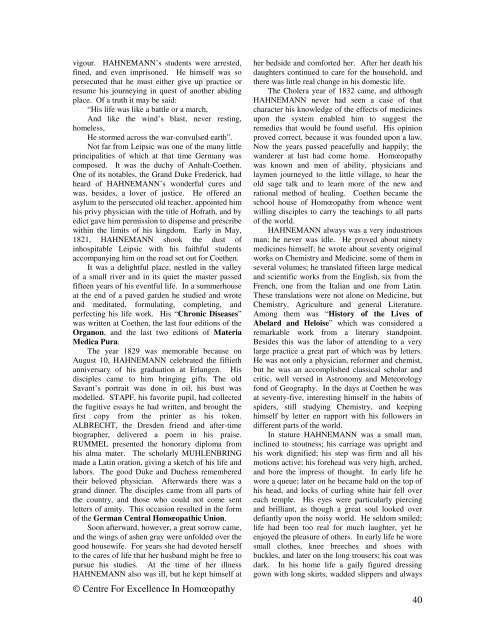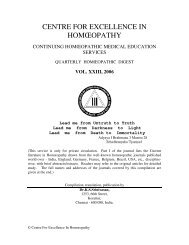You also want an ePaper? Increase the reach of your titles
YUMPU automatically turns print PDFs into web optimized ePapers that Google loves.
vigour. HAHNEMANN’s students were arrested,<br />
fined, and even imprisoned. He himself was so<br />
persecuted that he must either give up practice or<br />
resume his journeying in quest of another abiding<br />
place. Of a truth it may be said:<br />
“His life was like a battle or a march,<br />
And like the wind’s blast, never resting,<br />
homeless,<br />
He stormed across the war-convulsed earth”.<br />
Not far from Leipsic was one of the many little<br />
principalities of which at that time Germany was<br />
composed. It was the duchy of Anhalt-Coethen.<br />
One of its notables, the Grand Duke Frederick, had<br />
heard of HAHNEMANN’s wonderful cures and<br />
was, besides, a lover of justice. He offered an<br />
asylum to the persecuted old teacher, appointed him<br />
his privy physician with the title of Hofrath, and by<br />
edict gave him permission to dispense and prescribe<br />
within the limits of his kingdom. Early in May,<br />
1821, HAHNEMANN shook the dust of<br />
inhospitable Leipsic with his faithful students<br />
accompanying him on the road set out for Coethen.<br />
It was a delightful place, nestled in the valley<br />
of a small river and in its quiet the master passed<br />
fifteen years of his eventful life. In a summerhouse<br />
at the end of a paved garden he studied and wrote<br />
and meditated, formulating, completing, and<br />
perfecting his life work. His “Chronic Diseases”<br />
was written at Coethen, the last four editions of the<br />
Organon, and the last two editions of Materia<br />
Medica Pura.<br />
The year 1829 was memorable because on<br />
August 10, HAHNEMANN celebrated the fiftieth<br />
anniversary of his graduation at Erlangen. His<br />
disciples came to him bringing gifts. The old<br />
Savant’s portrait was done in oil, his bust was<br />
modelled. STAPF, his favorite pupil, had collected<br />
the fugitive essays he had written, and brought the<br />
first copy from the printer as his token.<br />
ALBRECHT, the Dresden friend and after-time<br />
biographer, delivered a poem in his praise.<br />
RUMMEL presented the honorary diploma from<br />
his alma mater. The scholarly MUHLENBRING<br />
made a Latin oration, giving a sketch of his life and<br />
labors. The good Duke and Duchess remembered<br />
their beloved physician. Afterwards there was a<br />
grand dinner. The disciples came from all parts of<br />
the country, and those who could not come sent<br />
letters of amity. This occasion resulted in the form<br />
of the German Central Homœopathic Union.<br />
Soon afterward, however, a great sorrow came,<br />
and the wings of ashen gray were unfolded over the<br />
good housewife. For years she had devoted herself<br />
to the cares of life that her husband might be free to<br />
pursue his studies. At the time of her illness<br />
HAHNEMANN also was ill, but he kept himself at<br />
© Centre For Excellence In Homœopathy<br />
her bedside and comforted her. After her death his<br />
daughters continued to care for the household, and<br />
there was little real change in his domestic life.<br />
The Cholera year of 1832 came, and although<br />
HAHNEMANN never had seen a case of that<br />
character his knowledge of the effects of medicines<br />
upon the system enabled him to suggest the<br />
remedies that would be found useful. His opinion<br />
proved correct, because it was founded upon a law.<br />
Now the years passed peacefully and happily; the<br />
wanderer at last had come home. Homœopathy<br />
was known and men of ability, physicians and<br />
laymen journeyed to the little village, to hear the<br />
old sage talk and to learn more of the new and<br />
rational method of healing. Coethen became the<br />
school house of Homœopathy from whence went<br />
willing disciples to carry the teachings to all parts<br />
of the world.<br />
HAHNEMANN always was a very industrious<br />
man; he never was idle. He proved about ninety<br />
medicines himself; he wrote about seventy original<br />
works on Chemistry and Medicine, some of them in<br />
several volumes; he translated fifteen large medical<br />
and scientific works from the English, six from the<br />
French, one from the Italian and one from Latin.<br />
These translations were not alone on Medicine, but<br />
Chemistry, Agriculture and general Literature.<br />
Among them was “History of the Lives of<br />
Abelard and Heloise” which was considered a<br />
remarkable work from a literary standpoint.<br />
Besides this was the labor of attending to a very<br />
large practice a great part of which was by letters.<br />
He was not only a physician, reformer and chemist,<br />
but he was an accomplished classical scholar and<br />
critic, well versed in Astronomy and Meteorology<br />
fond of Geography. In the days at Coethen he was<br />
at seventy-five, interesting himself in the habits of<br />
spiders, still studying Chemistry, and keeping<br />
himself by letter en rapport with his followers in<br />
different parts of the world.<br />
In stature HAHNEMANN was a small man,<br />
inclined to stoutness; his carriage was upright and<br />
his work dignified; his step was firm and all his<br />
motions active; his forehead was very high, arched,<br />
and bore the impress of thought. In early life he<br />
wore a queue; later on he became bald on the top of<br />
his head, and locks of curling white hair fell over<br />
each temple. His eyes were particularly piercing<br />
and brilliant, as though a great soul looked over<br />
defiantly upon the noisy world. He seldom smiled;<br />
life had been too real for much laughter, yet he<br />
enjoyed the pleasure of others. In early life he wore<br />
small clothes, knee breeches and shoes with<br />
buckles, and later on the long trousers; his coat was<br />
dark. In his home life a gaily figured dressing<br />
gown with long skirts, wadded slippers and always<br />
40




